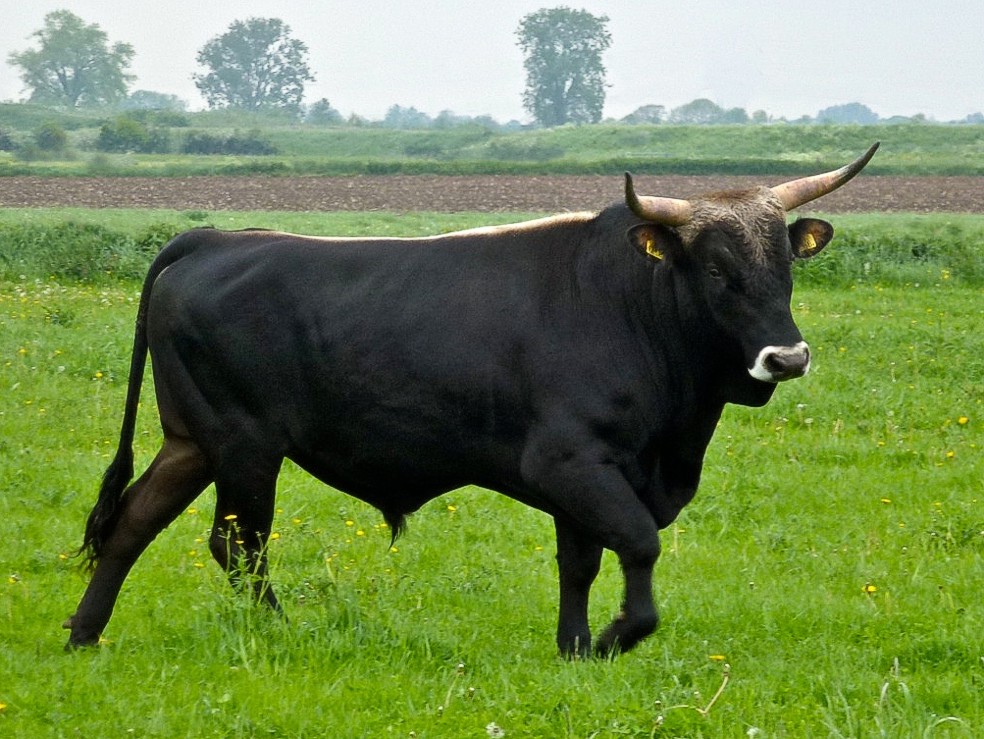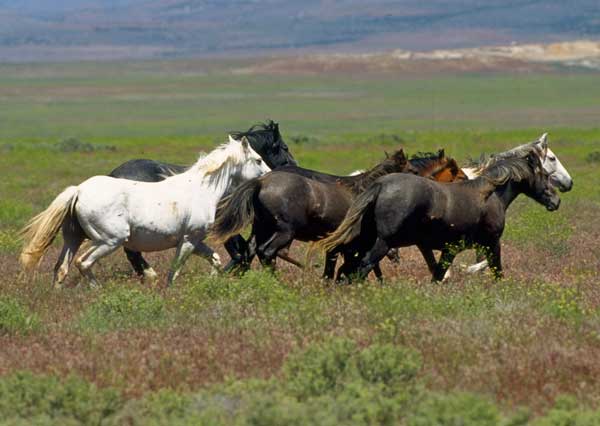Breeding-back
basically aims to unite certain traits that have been split up previously
and/or tries to establish resemblance to an archetype by selective breeding. The
first procedure only works if there are animals left that descended from the
beasts to be rebred. In most cases, these are domestic animals which’s
wild type has been wiped out. They
have been altered by domestication, but nevertheless they belong to the same
species as their wild types and display similar behaviour and similar ecologic
niches when released into the wild. So it is something completely different
trying to rebred an archetype from its descendants than one species from one or
more completely different species.
 |
| A first-generation Tauros bull living in the Netherlands (Image source: eurowildlife.org) |
Initially
it was believed that an extinct wild type animal could be re-bred from its
domestic descendants by crossing less-derived breeds and selecting for the wild
type features preserved in them. Nowadays it is clear that an extinct wild
type, such as the Aurochs, cannot be reconstructed completely by artificial
breeding only because man now can only work on a highly altered population of
the original species. There are several levels on which you can compare the
desired animal to its domestic descendants, such as genetic, phenotypic and
ecologic/ethologic.
Breeding-back usually emphasizes the phenotypic aspect because it is hoped that domestic
animals resemble their ancestor in ecologic functionality and therefore the
breeding-back result will do so, and the genetics of the lost wild types are
poorly resolved anyway. However, there are projects which claim to work on
achieving a genetic resemblance as well. In my personal view, it might be
questionable if the complete genotype of an extinct wild type can be re-bred
without using cloned individuals since domestic animals have been separated
from their ancestors for millennia (there possibly was local introgression,
though). Why not cloning the Aurochs or Tarpan after all? Certainly that would
be a very desirable option, but it seems technically out of reach at the
moment. The complete nuclear genome isn’t full resolved yet and that’s not easy
working only with ancient DNA bones and hair. And it would be a real challenge
to gather enough genetic material to recover a viable population.
The
phenotype of the species/wild type to be rebred is well-known in most cases,
although such factors as local or intraspecific variation are not satisfyingly
resolved. We can’t be sure if their descendants will occupy a
completely identical niche in nature because we can’t compare them directly –
although it seems very probable.
So we
simply have to face the fact that once these animals have been exterminated,
their variability, genetic distinctness and therefore unique identity was lost.
There is no scientific paper endorsing what I just said because it simply is so
obvious.
But why
should one make the effort of breeding-back then? Because it is a highly
interesting way to produce something that matches the lost wild type in at
least some way. Although we don’t know all aspects of their appearance exactly and
how variable it was, modern less-derived breeds of the species in question
still provide enough ancient-looking traits to restore what we know about the
phenotype. Although we can’t compare the ecologic functionality of a
breeding-back result with that of its archetype directly, it is likely that both work in a pretty
similar manner because they belong to the same species. Many domestic breeds
are hardy and robust enough to survive without man’s help, some even preserved
behavioural traits crucial for survival (as I will explain in future posts). The
genetic difference would still be there, as much as the vestiges of uncertainty
if the picture that is provided really is completely authentic, but still
breeding-back is a much better perspective than having no animals in the nature
filling the vacant niches of their ancestors and having no animals that provide
a model for what these animals looked like, how they lived and behaved.
Wait a minute, behaviour? How could we possibly
know if a breeding-back result behaves like the extinct animal it was bred to
resemble? Well, we shouldn’t expect great behavioural matches if they are kept
in zoos or on farms. But when released into wild and being able to display the
natural behaviour of their species they might greatly resemble their wild type,
especially because nature enforces those ethologic traits that are necessary to
survive and eliminates those reducing its chances for survival and
reproduction. And there are actually some decent matches between what we know of
the behaviour of the aurochs and what is displayed by modern cattle, and cattle
and horses living under natural circumstances do show behavioural traits that
can be interpreted as natural instincts enhancing their reproductive fitness. I
will go into greater detail in later posts.
 |
| Feral Mustangs display behavioral patterns similar to wild equines (Image source: Wikipedia) |
And why
does nature need proxies for those extinct species? This may be the most
frequently asked question concerning breeding-back. Actually, nature does not
“need” anything. Evolution is resilient and will recover from any big hits. But
conservation tries to preserve and protect as much as possible from the often
destructive (or more neutrally: diversity reducing) influence of man. The
recovery of any species that has been extirpated from an ecosystem is
desirable, be it in the original or in an altered form. Secondly, it is
well-supported that megaherbivores help to create a diverse landscape that
inhabit a larger number of species than a homogenous climax vegetation would
do, and the excrements and cadavers of large herbivores increase the
productivity of the ecosystem as it provides more resources for loads of insect species that are prey of various birds, amphibians and reptiles. The positive influence of large herbivores in
natural habitats is well-documented and I can only refer you to the literature
listed down below (mostly in German). It is obvious that megaherbivores, which
have been part of Europe’s evolution since millions of years, are an important
component of the faunal assemblage on this continent and therefore their
reintroduction is something very important to create a completely
self-suistainable European wilderness area. Imagine elks, wisents, red deer,
aurochs and wild horses living together in one large natural landscape being
the prey of native European predators. The fauna simply wouldn’t be complete
without proxies for those species that have been wiped out and their absence
would have consequences for biodiversity as well: without megaherbivores Europe
possibly would be covered by large areas of climax vegetations consisting
mainly of forests, and a reduced number of habitat types means a reduced number
of species. Therefore, many floral and faunal inhabitants of open, park-like
landscapes or grasslands would probably die out. Mowing and cutting in reserves, as it was practised before megaherbivores received a new role in conservation, certainly is no perspective for a self-sustaining
nature area.
 |
| The Cattle Egret, Bubulcus ibis, is one of the many bird species that benefit from the presence of megaherbivores (Image source: Wikipedia) |
If it is
such an important tool of conservation, why is there little to no scientific
literature on breeding-back? In my opinion, it was the exaggerated enthusiasm
and lack of objectivity of the Heck brothers and their followers that caused
many scientists to either be cautious or dismiss it. The Hecks claimed they
have revived the Aurochs and Tarpan although some important differences between their
cattle and its archetype were evident already back in the 1940ies, and the authenticity
of Heck cattle has been (and is) defended in a very pseudo-scientific manner by
some advocates of the breed. Also, as I explained above, it is quite obvious
that selective breeding with domestic animals cannot revive a wild type species
completely, so it’s only understandable that some scientists did not consider
the progress of breeding-back worth to be investigated at all. And, most
importantly, many dismiss breeding-back because it creates the wrong picture
that once a species is lost it could be rebred anyway, diminishing the public
awareness for why species conservation is very important. So if you are
interested in breeding-back you are dependent on the information provided by
the different projects themselves and can only try to stay objective and not be
inveigled by awesome stories but try to find out what is reliable information
and what is not.
“Breeding-back”
actually is a horrible term. The word alone is an enthusiastic
oversimplification already, because the real extinct animals can’t be truly “bred back”. You won’t see me writing phrases like “breeding-back the aurochs”
or some sort, but only “breeding-back its
phenotype” or whichever traits are in the focus.
In Germany,
Rückzüchtung has been largely replaced by Abbildzüchtung, what I loosely translate
with effigy breeding. It is more
neutral because it admits that breeding-back mainly focuses on phenotypic
traits and results in an animal that mimics
or approaches the extinct creature.
But it sadly neglects the fact that breeding-back often also focuses on
producing hardy animals that are suited to survive in nature, and not merely
optical doubles with no ecologic capacities. Anyway, I am going to use that
term in this blog frequently, especially when referring to very phenotype-based
projects like the Quagga Project.
Literature
- Baumgart, B.: Vor und nacheiszeitliche Großtierformen in Mitteleuropa und ihre Einpassung in das Ökosystem – Stand der Projektentwicklung zum Großtier-Schutzgebiet Teltow-Fläming. 1997
- Bunzel-Drüke, Magret; Drüke, Joachim; Vierhaus, Henning: Der Einfluss von Großherbivoren auf die Naturlandschaft Mitteleuropas. 2001
- Beutler, Axel: Die Großtierfauna Europas und ihr Einfluss auf Vegetation und Landschaft. 1996
- Wiegleb, Gerhard; Krawczynski Rene: Biodiversity Management by Water buffalos in Restored Wetlands. 2010
- Stumpf, Thomas: Machbarkeitsstudie zum Einsatz von Wasserbüffeln in der Landschaftspflege im Rheinland
- Donlan et al.: Pleistocene Rewilding: An Optimistic Agenda for Twenty-First Century Conservation. 2006
- Bunzel-Drüke, Magret; Drüke, Joachim; Vierhaus, Henning; Hauswirth, Luise: Großtiere und Landschaft – Von der Praxis zur Theorie. 1999
-
Bunzel-Drüke, Finck, Kämmer, Luick, Reisinger, Riecken, Riedl, Scharf & Zimball: „Wilde Weiden: Praxisleitfaden für Ganzjahresbeweidung in Naturschutz und Landschaftsentwicklung“. 2010
